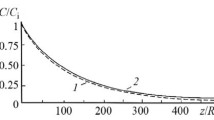Turbulent fl ow of aerosols in a cylindrical channel has been investigated. Differential equations of transfer of dispersed particles have been considered, and a two-dimensional equation with a mass source has been solved. Different numerical experiments have been conducted on the basis of the model proposed. Air with water droplets was used as a gas-liquid mixture in the calculations. The influence of the spraying of the channel, the fl ow velocity, the diameter of dispersed particles, and the water concentration on the separation efficiency of an aerosol have been studied. Agreement with experimental data has been shown. A mathematical model has been developed that can be used in designing gas-cleaning apparatuses for enterprises of various industries.
Similar content being viewed by others
References
M. G. Ziganshin, A. A. Kolesnik, and V. N. Posokhin, Designing Dust- and Gas-Cleaning Apparatuses [in Russian], "Ékopress-3M," Moscow (1998).
A. A. Ovchinnikov, Dynamics of Two-Phase Swirling Turbulent Flows in Vortex Separators [in Russian], ZAO "Novoe Znanie," Kazan (2005).
E. V. Sugak, N. A. Voinov, and N. A. Nikolaev, Cleaning of Gas Effluents in Apparatuses with Intense Hydrodynamic Modes [in Russian], ZAO "Novoe Znanie," Kazan (2010).
A. N. Chokhonelidze, V. S. Galustov, L. P. Kholpanov, and V. P. Prikhod′ko, Handbook of Sprayer, Irrigating, and Droplet-Collecting Units [in Russian], Énergoatomizdat, Moscow (2020).
A. G. Laptev and M. I. Farakhov, Separation of Heterogeneous Systems in Nozzle Apparatuses [in Russian], Izd. Kazan. Gos. Énerg. Univ., Kazan (2006).
E. P. Mednikov, Turbulent Transfer and Deposition of Aerosols [in Russian], Nauka, Moscow (1980).
A. G. Laptev, M. M. Basharov, and A. R. Iskhakov, Model of transfer of a fi nely dispersed phase in turbulent gas media, Vestn. Kazan. Tekhnol. Univ., No. 14, 96–99 (2012).
N. A. Nikolaev, L. P. Kholpanov, V. A. Malyusov, and N. M. Zhavoronkov, Intensifi cation of the transfer of mass in a liquid fi lm moving concurrently with a high-velocity fl ow of a gas or a vapor, Teor. Osn. Khim. Tekhnol., 23, No. 5, 563–568 (1998).
Author information
Authors and Affiliations
Corresponding author
Additional information
Translated from Inzhenerno-Fizicheskii Zhurnal, Vol. 87, No. 3, pp. 564–569, May–June, 2014.
Rights and permissions
About this article
Cite this article
Laptev, A.G., Iskhakov, A.R. Mathematical Model for Determinating the Efficiency of Separation of Aerosols in Dry and Sprayed Channels. J Eng Phys Thermophy 87, 582–587 (2014). https://doi.org/10.1007/s10891-014-1048-7
Received:
Published:
Issue Date:
DOI: https://doi.org/10.1007/s10891-014-1048-7



